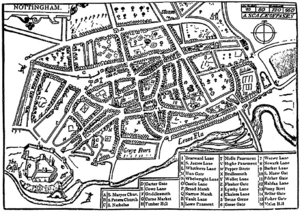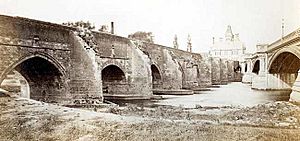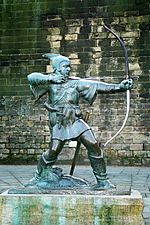History of Nottingham facts for kids
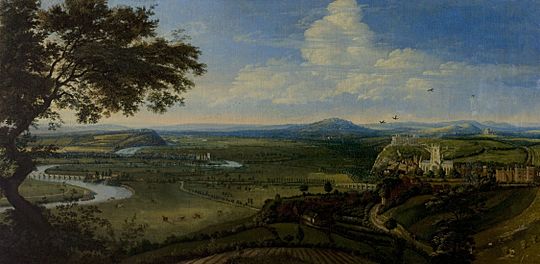
This article tells the exciting story of Nottingham, from ancient times to more recent history. Get ready to explore how this city grew and changed over thousands of years!
Contents
Ancient Times: Before Nottingham Was a City
Ice Age and Early Humans
Long, long ago, between 500,000 and 10,000 years ago, huge ice sheets covered the area where Nottingham is now. Because of this, we don't find much proof of early humans living here. Only a few stone tools have been found, left behind by people who lived during the Paleolithic (Old Stone Age).
Hunter-Gatherers and Early Farmers
After the ice melted, around 10,000 BC to 4,000 BC (the Mesolithic or Middle Stone Age), the climate became warmer. This allowed hunter-gatherers to move into the Trent Valley. They hunted animals and gathered plants in the new forests. We know they were here because flint tools have been found at Nottingham Castle and in areas like Beeston and Wollaton Park.
Later, in the Neolithic (New Stone Age), from 4,000 BC to 10,000 BC, people started clearing forests to farm. This was a big change! Pottery from this time has been found in places like Attenborough. Stone axes from as far away as the Lake District and North Wales show that people traded goods. One important site is at Holme Pierrepont, where an ancient burial mound with ditches was found.
Bronze Age Discoveries
The Bronze Age (when people used bronze for tools and weapons) left lots of clues in the Nottingham area. Tools and weapons made of bronze have been found in the River Trent. A large collection of bronze items, including axes and arrowheads, was found in Great Freeman Street in 1860.
Archaeologists also found what might have been a Bronze Age home in Clifton. It had wooden stakes in the riverbed and many bronze items like spearheads and swords. Burial sites from this time, marked by circular ditches, are common around the Trent. These sites often contain evidence of cremations and pottery urns.
Iron Age Life
During the Iron Age (700 BC to 43 AD), more people lived in the area. They had many small farms, growing crops and raising animals. Iron Age pottery has been found in the city centre, including near the Castle and in the Lace Market.
At Gamston, excavations showed that people made pottery and textiles. They also traded far and wide, getting salt from Cheshire and grinding stones from the Pennines. The River Trent was an important trade route, as shown by the discovery of ancient dugout canoes. Early ditches found at Nottingham Castle and in the Lace Market suggest that these areas might have had defenses even back then.
Roman Times and Beyond
It's interesting that Nottingham doesn't have much evidence of Roman life. Even though a major Roman road, the Fosse Way, passed close by, there are no records of a Roman town or crossing of the Trent near modern Nottingham.
After the Romans left Britain around 410 AD, new kingdoms formed. The Nottinghamshire area was briefly part of a kingdom called Elmet until the early 7th century.
Anglo-Saxon Nottingham: The Birth of a Name
Around 600 AD, in Anglo-Saxon times, the area became part of the Kingdom of Mercia. It was first known as "Tigguo Cobauc," which meant "a place of cave dwellings." Later, a Saxon leader named Snot settled here. The place then became known as "Snotingaham," meaning "the homestead of Snot's people." Snot gathered his people in the area we now call the Lace Market.
The first written mention of Nottingham was in 868, in the Anglo-Saxon Chronicle. This name suggests that Nottingham was an important settlement for the Snotingas tribe. Anglo-Saxon pottery and defensive ditches from the 7th or 8th century have been found in the Fisher Gate area, showing an early fortified settlement.
Nottingham was likely a royal centre for the Mercian kings. Large timber halls, similar to royal palaces, have been found in Halifax Place and High Pavement. These halls were rebuilt several times, showing the importance of the settlement.
In 867, Danish Vikings captured Nottingham. It later became one of the Five Burghs, or fortified towns, of The Danelaw, a part of England ruled by Vikings. The first bridge over the River Trent is thought to have been built around 920.
Medieval Nottingham: Castles and Growth
11th Century Beginnings
Nottingham is mentioned in the 1086 Domesday Book as "Snotingeham." In the 11th century, Nottingham Castle was built on a sandstone hill overlooking the River Trent. This castle was very important!
An English town, the Borough of Nottingham, grew around the castle. It had a Town Hall and courts. A separate French town also grew nearby, supporting the Norman people in the castle. Over time, these two settlements grew together, and the Old Market Square became the heart of Nottingham.
Later Medieval Developments
The building of St Peter's Church, Nottingham began around 1180. In 1276, a group of Carmelite friars (religious brothers) set up a monastery on what is now Friar Lane. They even had a guesthouse.
In 1392, Plumptre Hospital was founded. This charity has helped people in Nottingham for a very long time! In 1449, Nottingham became a "county corporate," which meant it could govern itself, almost like its own small county.
Modern Nottingham: From Wars to Industry
17th Century Challenges
A big event happened in Nottingham in 1642: King Charles I of England raised his Royal Standard here, marking the start of the English Civil War. This was a very important moment in British history. Around 1688, one of the first banks outside London, Smith's Bank, opened in Market Square.
18th Century Transport
In 1783, the Trent Navigation Company was formed to make the River Trent easier for boats to travel on. Then, in 1796, the Nottingham Canal opened. This was a huge deal because it cut the price of coal in Nottingham in half!
19th Century: The Industrial Revolution
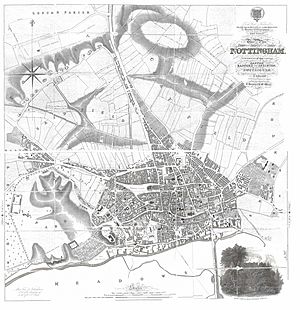
The 1800s were a time of massive change. In 1821, Coal gas was brought to Nottingham for lighting. In 1831, Nottingham was the first place in Britain to have a constant supply of high-pressure mains water, thanks to engineer Thomas Hawksley. The first railway service between Nottingham and Derby opened in 1839.
Nottingham became famous for its textile industry, especially lace making. However, the city grew very quickly and without much planning. This led to some of the worst living conditions in the British Empire. In 1831, people living in these poor areas rioted and even set fire to Nottingham Castle to protest against unfair laws.
Important companies like the Raleigh Bicycle Company and Boots the Chemist also started in Nottingham during this century. The city expanded in 1877, adding nearby areas like Basford and Sneinton.
In 1874, the first incinerators for burning waste were built in Nottingham. Horse-drawn trams started running in 1878. In 1889, Nottingham became a "county borough," giving it even more control over its own affairs. It was officially given "City status" in 1897 to celebrate Queen Victoria's Diamond Jubilee. The Great Central Railway opened Nottingham Victoria railway station in 1899.
20th Century: Wars and Changes
Electric trams began operating in Nottingham on January 1, 1901. The Nottingham Council House was rebuilt between 1927 and 1929.
World War II
During World War II, Nottingham faced the "Nottingham Blitz." On May 8/9, 1941, German planes bombed the city. This was part of a plan to damage factories and lower people's spirits. In one raid, 140 people were killed, and 4,500 houses were destroyed. Large parts of Nottingham were flattened, and University College Nottingham was damaged.
Economic Shifts
After World War II, Nottingham's textile industry, like many in the UK, declined. It became hard for British factories to compete with cheaper goods from other countries. Today, very little textile making happens in Nottingham. However, the city's past wealth from textiles left it with beautiful old industrial buildings in the Lace Market. Many of these have been fixed up and are now used for new things.
Famous Nottingham: Robin Hood
The legend of Robin Hood started in the Middle Ages. Robin Hood is said to have lived in Sherwood Forest, which stretched from north of Nottingham. While people often connect him to Nottingham, some think he might have been from Yorkshire. Robin Hood's main enemy was the Sheriff of Nottingham. Today, the Sheriff of Nottingham is a special ceremonial role, not a real law enforcer.
Even if the exact story isn't true, the legend has had a huge impact on Nottingham. You'll see Robin Hood everywhere, from local businesses to tourist attractions. There's even a Robin Hood Statue near the Old Market Square.
Nottingham's Hidden World: The Caves
The Nottingham Caves are a fascinating part of the city's history. They are not natural caves but were carved out of the soft sandstone rock by people. They grew into a huge network under the city. The oldest parts date back to 1250. Nottingham has more man-made caves than anywhere else in the country! This whole cave system is protected like Stonehenge, making it very important to the UK's history.
Before the Industrial Revolution, the caves grew even bigger. Many poor people lived in them, especially those who worked in the tanning industry (making leather). By the 18th century, most caves were used for storage. Some families lived in them until about 1924. During World War II, they were used as air raid shelters.
Today, you can visit part of the network at the City of Caves attraction, which is accessed from the Broadmarsh Shopping Centre. Some parts are still used as pub cellars! Another section under the castle is used as a rifle range. The famous pub, Ye Olde Trip to Jerusalem Inn, which claims to be Britain's oldest pub, is partly built into the cave system below the castle. Its cellars connect to the castle through the caves.
Nottingham Castle: A Royal Stronghold
Nottingham Castle, first built by William the Conqueror, was once one of England's most famous strongholds. It's also where Charles I started the English Civil War in 1642.
However, the medieval castle you read about no longer stands. It was replaced by a grand palace. Today, you can still see the restored gatehouse and some ruined walls of the original castle.
Images for kids


